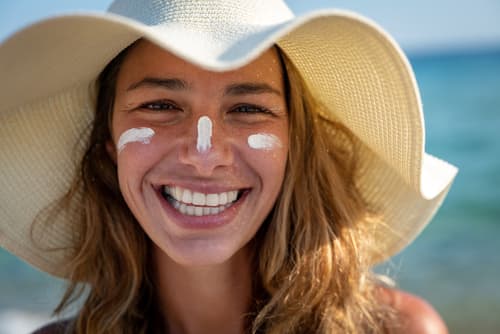
July is designated as UV Awareness Month and for good reasons. Many people wait until the height of summer to protect their skin from the sun because they spend more time outside or at the beach. However, sun exposure happens all year long and it is necessary to use sunscreen properly to protect your skin no matter what month of the year.
Three Steps to Minimize Sun Exposure
The American Academy of Dermatology works to raise awareness that the ultraviolet (UV) rays of the sun are the main cause of most skin cancers. Practicing safe sun efforts all year – not just in the super-sunny and hot month of July – is one of the best precautions you can take to protect your skin. The three simple steps promoted by the AAD include:
- Seeking shade when appropriate. If you’re sitting outside, awnings and umbrellas offer true shade. If you’re in direct sunlight, take breaks from the sun’s rays in shaded, cool areas.
- Wearing sun-protective clothing. Lightweight and long-sleeved shirts, wide-brimmed hats, and sunglasses with UV protection are best. Some clothes come with a UPF label that offers ultraviolet protection.
- Wearing sunscreen. Apply broad-spectrum, water-resistant sunscreen, with an SPF of 30 or higher. It can be complicated to select sunscreen for your skin and everyone in your family, but it is a necessary investment that offers essential protection.
Decoding Sunscreen Labels for UV Awareness
Every bottle or can of sunscreen comes with copious amounts of information on all sides of the container. Here is the information to focus on so you can decode the most pertinent details to protect your skin effectively and your family’s skin.
- Broad spectrum. This type of sunscreen protects skin from the harmful ultraviolet rays of the sun. The UVA rays age the skin and UVB rays burn skin, so protecting yourself against them with broad spectrum sunscreen helps prevent skin cancer, premature skin aging, and sunburns.
- SPF. The sun protection factor (SPF) assigned to a sunscreen tells you how much of the burning rays it can filter out. The higher the number the better the protection. The AAD explains that SPF 15 can filter 93% of the sun’s UVB rays and SPF 30 can filter 97%. No sunscreen can filter out 100% of the sun’s UVB rays, so even if you wear SPF 50 or higher, there is no total protection.
- Waterproof vs. water-resistant. Waterproof is a misnomer. Water and sweat wash sunscreen away. Water-resistant is more accurate because sunscreen can stay on wet skin for an hour or so, depending on the product. Then reapplication is necessary. Follow instructions on the sunscreen container.
Enhance Your UV Awareness
Skincare is essential to overall health and wellness. Make an appointment with me, Dr. Maria Swetech, to discuss routine screenings for your skin, skin health, and taking care of your skin in the sun. Schedule an appointment today.
Nothing in this blog is official medical advice. See your doctor for customized care.